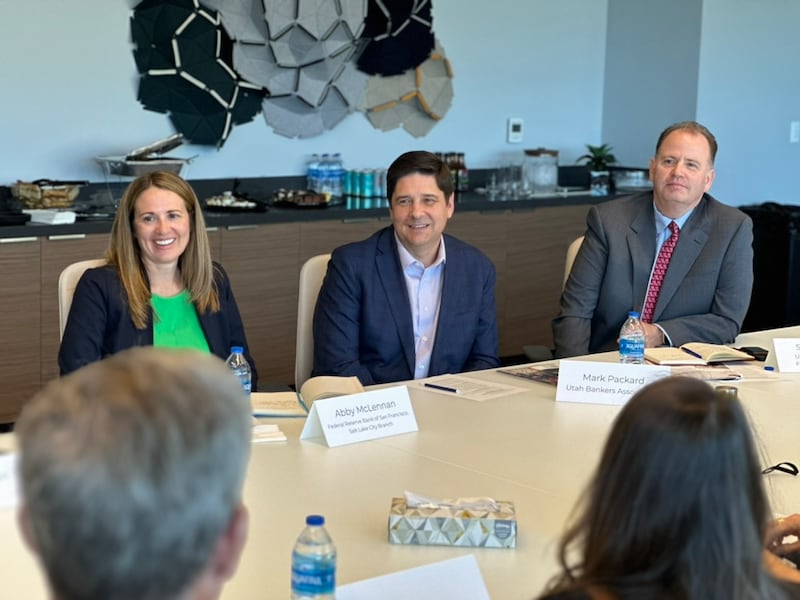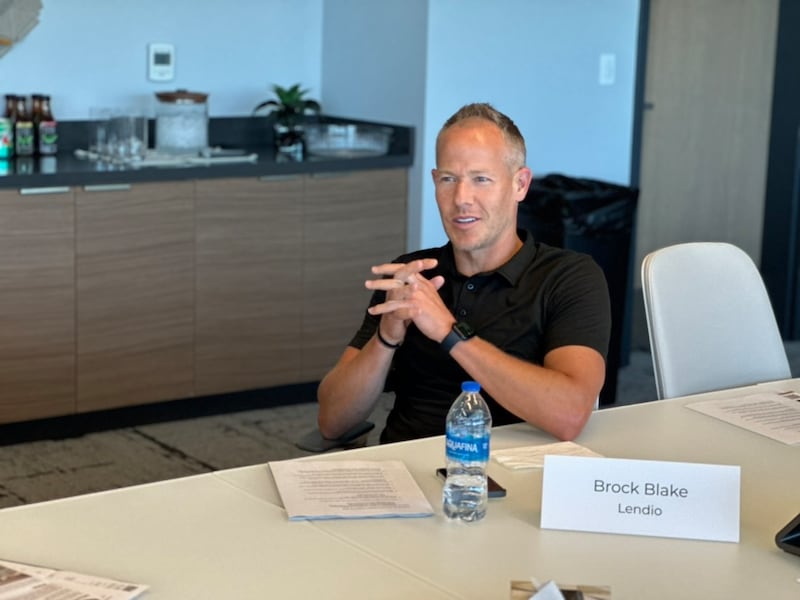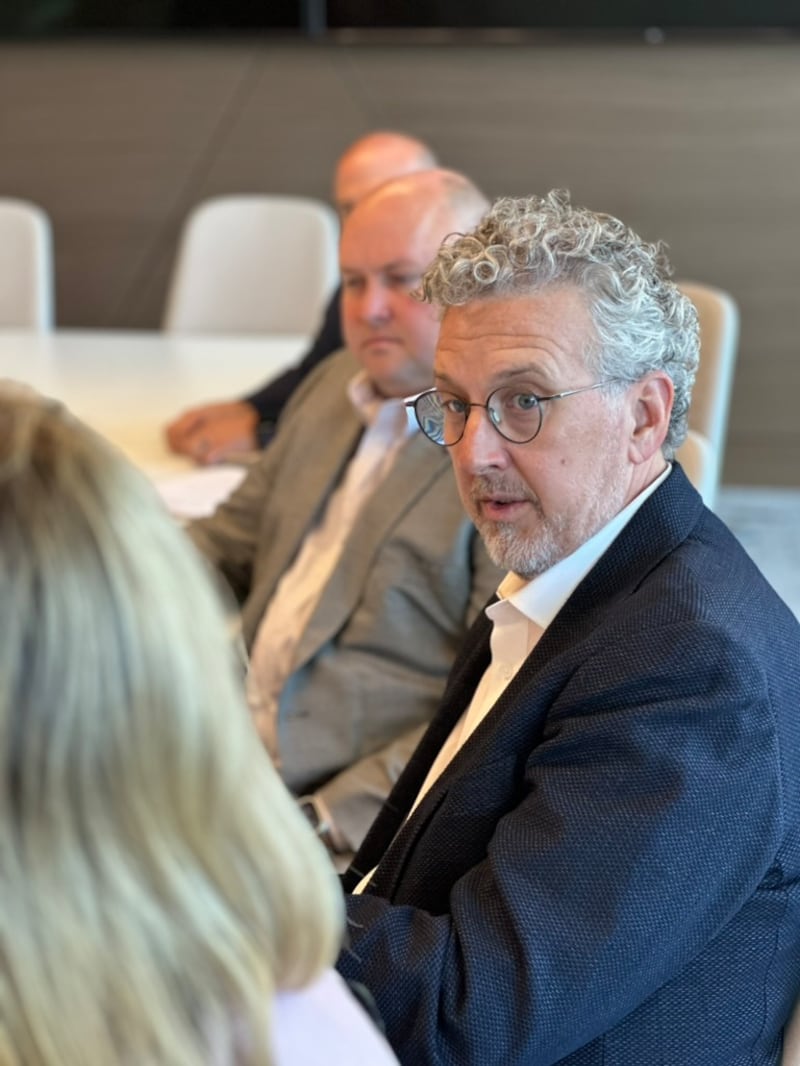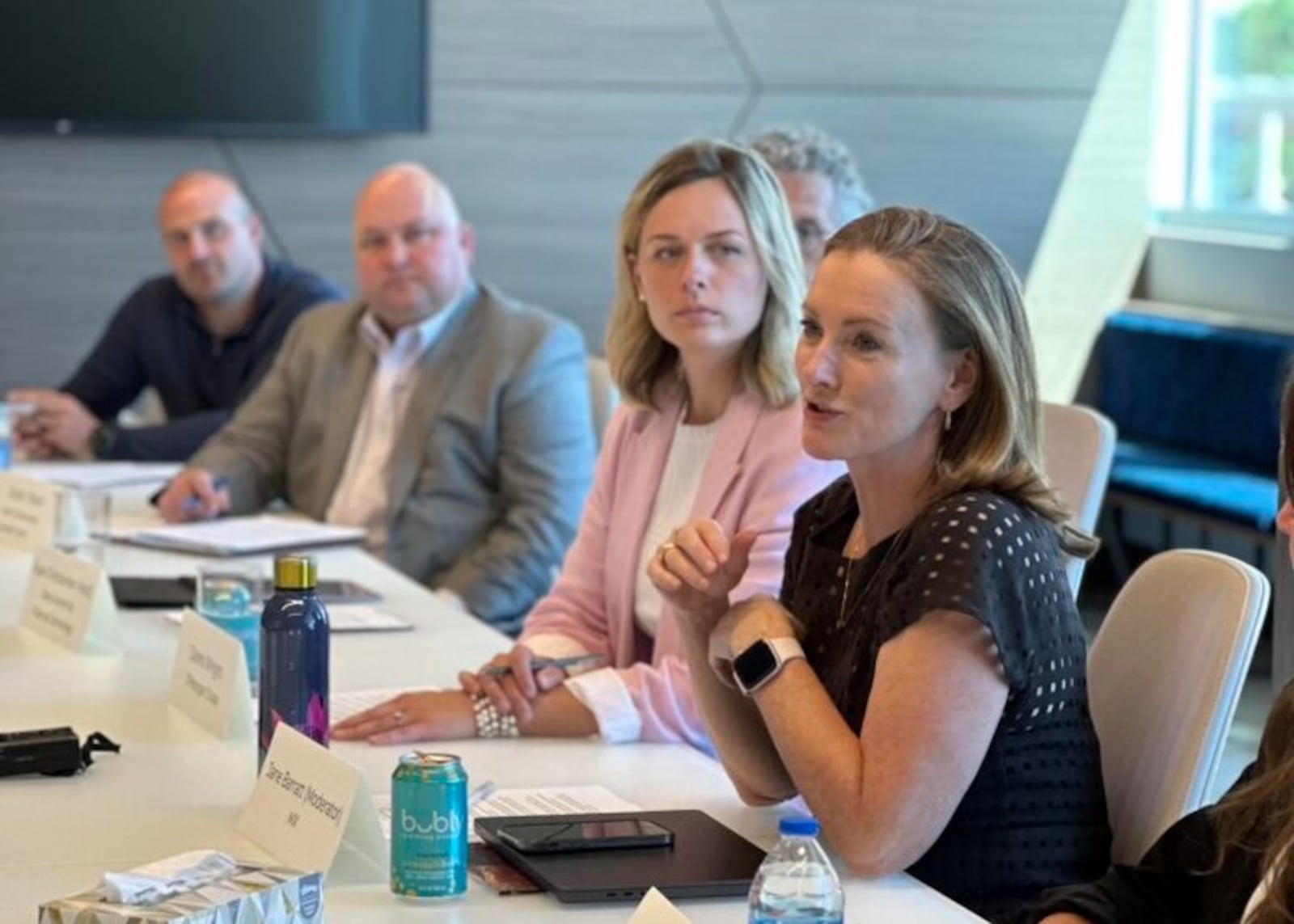This story appears in the September issue of Utah Business. Subscribe.
Last month, Utah Business partnered with the Stena Center for Financial Technology at the University of Utah to host a roundtable featuring Utah’s financial services experts. Moderated by Jane Barratt, chief advocacy officer and head of global public policy at MX, participants discussed emerging technologies, the current regulatory environment, Utah’s unique advantages and more.
What’s your pulse on the current regulatory environment?
Frank Pignanelli | Executive Director | National Association of Industrial Bankers & Utah Association of Financial Services
Toward the end of last month, the FDIC issued several rules regarding fintechs and broker deposits. There’s a new rule that would make it almost impossible for the applicant to be approved for FDIC insurance, … and they made it very clear that they’re going to apply the philosophy of this rule to existing charters. When I say existing charters, I mean not just industrial banks — any other bank that relies a little bit on a parent or some type of line of lending is going to be examined by the FDIC, so we are at DEFCON 1 against these rules.
We have a lot of allies in the fintech area that are also concerned about this rule. It really squeezes the ability to provide innovative banking, whether that’s an ILC [industrial loan company] or a community bank. … Do you want a Canadian system of a handful of big banks and maybe a couple of small banks, or do you want this innovative ecosphere that we have here in Utah and other places? It really is a battle of ideologies that is happening not just here in Utah, but in Washington, D.C.
Rhett Roberts | Co-Founder & CEO | LoanPro
The velocity of the rules changing, on one hand, is choking out some of the innovation. On the other hand, the regulator is not paying a lot of attention to the actual implementation of these things. … Some of the rules have implementation windows shorter than the release cycles of the software companies they operate on, so it’s kind of forcing innovation to happen.
Judd Austin | Chief Banking Officer | Altabank
As a community bank, the regulations that are being considered are fundamentally changing our model, and the technology that’s out there is making a shift from a “We take deposits and make loans” mentality to a “How do we manage the data? How do we compliantly meet it?” mentality. The fastest rate of hiring we do is in compliance, which in today’s world is sad because we would rather be hiring loan officers, deposit teams and treasury teams to go out and help and really add value for the client, but we’re focused on making sure we don’t end up out of business because we charge a fee that a regulator considers a junk fee.
Shaun Berrett | Chief Examiner | Utah Department of Financial Institutions
I think the regulators get that unique opportunity to go out and spend time in each of the institutions … and see how different institutions apply their practices, policies and procedures. We get to see what the strong practices and the weak practices are. I think it’s taken a number of years for that to happen on the national stage, and now that it’s happening, you’re seeing some of those enforcement actions for some of the banks that partner with fintech companies.
Ryan Christiansen | Executive Director | Stena Center for Financial Technology
I think we’ve got a big moment here with Section 1033 and data rights for consumers. This is the first time we’ve had data rights for consumers and the ability to get that rolled out to every bank in the United States. … I think the opportunity there is to push that into the new frontiers of open finance so that consumers can actually have those same rights with their payroll data.

What makes Utah a hotbed for financial services innovation?
Frank Pignanelli | Executive Director | National Association of Industrial Bankers & Utah Association of Financial Services
In 1987, the state of Utah was in a real financial crisis. The rest of the country was pretty much enjoying an economic boom, but not Utah. Geneva Steel had closed, Kennecott had closed, a bunch of other businesses had closed, and we were in a deep recession. … Utah leaders — not just the legislature and the governor, but [Utah Department of Financial Institutions Commissioner] Ed Leary and others — started looking at what we could do. When the CEBA Act [Competitive Equality Banking Act] passed in 1987, Leary said, “We’re going to make this a powerhouse for industrial loan corporations.” Sure enough, within several years, General Electric, AT&T and others came in. I think there are a lot of different reasons why, but I think it’s because we became a model of innovation. … Today, financial services is now the largest economic sector of the state, and we have a great pool of talent and a great ecosystem as a result.
David Stahl | President, Utah & Idaho | Hillcrest Bank
I moved here five years ago and picked Utah specifically because of the great views and the fact that it is the fifth-largest banking state in the country. As a career banker with a lot of time left in the seat, I needed a big financial ecosystem, … The bank chose it because of the great tailwinds the state has.
Mark Packard | Chairman, Utah Bankers Association | CEO & President, Central Bank
The University of Utah has started some courses that specifically focus on banking. We’re also doing training for bankers who want a career to get more education and information about banking. A lot of people who come to banking come by it accidentally; They start as a teller and get their interest piqued. To have that training and have them continue is going to be vital.
Mark Zupon | CEO & President | First Utah Bank
A lot of people come out of school and don’t think of banking. They think it’s boring — you walk into a bank, you get money. They don’t realize that, for everything a bank does, you’ve got people in marketing, IT, finance, accounting. There are so many different parts of banking, and it’s a very dynamic industry.
Shaun Berrett | Chief Examiner | Utah Department of Financial Institutions
I have several kids. I constantly tell them, “We are a large banking state. Go do some self-study and get a couple of BSA/AML [Bank Secrecy Act/anti-money laundering] certifications. You will never want for a job again.” If you can develop those specialized skills that are super valuable to these institutions, you can really have a career here.

What challenges and opportunities do you see with AI?
Danni Wright | Managing Director, Head of Utah & Idaho | J.P. Morgan Private Bank
If you look at the percentage of dollars we’re spending on technology and fraud prevention and the fintech that we were buying, it’s a great portion of our entire spending. I think part of the reason people say banking is boring is because there are a lot of mundane tasks that all of us have to do. If we can automate that, I think we’ll attract better talent, create better outcomes for our customers and clients, and be more efficient. There are also concerns about AI going too far, so we’re trying to navigate that balance right now. A lot remains to be discovered and learned, and we’re looking for people who understand AI to work in banking because they’re the ones who are going to help us figure it out.
Justin Olson | CEO & President | Utah Community Credit Union
The biggest opportunity in AI is about giving humans better judgment, flagging some risks they might not have seen initially, and putting some guardrails around the joyless work. Compliance, AI and risk are all really complementary. They’re not hurdles; they’re enablers of each other.
I think consumers’ financial lives are so fragmented. If we look at it, they probably bank with all of us. That’s the promise of open banking: You can get a holistic view of a consumer’s life. They can, too, and it can help them make better-informed decisions. But it’s also really nuanced and risky. … You can tell that open banking is still very much like a teenager. It’s unruly. It needs some help, but it’s still growing up. The people who use it on average add five accounts to our online banking. They can see relationships more broadly. Their overall financial health is much better than consumers who don’t use those tools.
Brock Blake | Founder & CEO | Lendio
We work with a bank down in South Texas. One of the AI services they use looks at deposit account transaction data and evaluates that data to determine the cash flow health of the business. Then, once the cash flow health is identified, does it meet the credit policy of the financial institution? They did this and found about 40 percent of their deposit base would meet their credit policy. One of these customers was a Mexican woman who owned a really, really profitable business and had never taken a loan in her life. Part of the reason why she never took a loan was because she was really nervous to go in the branch. There was a little bit of a language barrier. She also had a thin credit profile. They ended up sending the loan to her, and the loan is performing. This is exactly what we want to do as a financial institution. We never would have lent to this customer had we not used some of these tools to open up and look at the cash flow of the business a bit differently than they would’ve looked at it historically.
David Stahl | President, Utah & Idaho | Hillcrest Bank
If regulation and compliance are risk No. 1 to our industry, No. 1A is fraud and the impact that has. Bad actors are using this technology to defraud us. I think there’s a tremendous opportunity to have AI and other technological advances help us combat them … while we’re tripping over regulatory and compliance issues, we’re also trying to combat fraud because we are constantly under attack.
If you had a magic wand, what would you do for Utah to drive the next generation of innovation, inclusion, success and growth here?
Brock Blake | Founder & CEO | Lendio
I don’t know if it’s a talent shortage problem or a marketing problem. Do we have talent shortages across the entire workforce in Utah? Or is it just that people aren’t choosing to go to banking because it doesn’t look exciting? … I think that if the younger generation really knew what the opportunity looked like, I think there would be a lot more talent.
Danni Wright | Managing Director, Head of Utah & Idaho | J.P. Morgan Private Bank
Financial education for all. I work in wealth management and see people at a certain stage of life. Sometimes, I am surprised by the things that could be very helpful to someone’s financial life that they don’t yet know about. I know there are many programs in high school and college trying to teach financial well-being. I also would point out that certain groups have less financial education than others, whether that’s [based on] gender or certain minority groups. I think being able to tap into those groups and promote financial education would benefit the whole system.
Shannon Drage | Director, Investor Relations & Strategic Finance | Zions Bancorporation
I would build on the things that have already been made. If you think about Utah, technology and executive leadership in banking, these are three areas in which women are not represented equally. I think that’s something that could really help us as an industry and could help with innovation. We know it’s good for financial outcomes when women have equity.
Mark Packard | Chairman, Utah Bankers Association | President & CEO, Central Bank
In the current environment, regulatory bodies don’t want competition. They’ve shut down de novos in the marketplace. I’m a firm believer that increased competition actually brings better innovation and drives all of us to be better. My wish is that we get more de novos, institutions and competition. That would make us all have to look at who we are and what we’re doing and make us better for our customers.
Ryan Christiansen | Executive Director | Stena Center for Financial Technology
My magic wand would be that we do it better in Utah than anywhere else, and I think we’ve got the head start. How do we make that more inclusive, double down on our wins, and do it in a sustainable way so that we can continue the success we’ve had?
Justin Olson | CEO & President | Utah Community Credit Union
One of the top predictors of life success is the ability of a child to read at their grade level when they are in the third grade. What’s the No. 1 predictor of financial success or improved financial strength in someone’s journey? How do we help more people be better educated about financial things but also read at the third-grade level in the third grade?
My other magic wand would be to have a regulatory sandbox where we can run some proof-of-concept tests — maybe there are certain parameters around that, but especially with AI, open banking and other things where the risks are huge but the rewards could also be really big.
It’s hard to run some proof-of-concept tests without worrying about the CFPB, FDIC or other regulations. If we could proof-of-concept some things out in a real market test without some of the shackles regulations sometimes impose, I think we could be more innovative, more forward-looking and less worried.
Jen Thornburgh | VP, Operations | BlytzPay
My mom was a real estate agent and had poor behavior around finances my entire life. My next-door neighbor actually set me up a bank account when I was in fifth grade. … She taught me all these lessons that I genuinely would not have learned otherwise. My mom, to this day, does not have a bank account. With a magic wand, I’d put a big emphasis on teaching financial education at a young age.
Judd Austin | Chief Banking Officer | Altabank
I had a great mentor who said, “Whenever you have a meeting, somebody in the room has to say, ‘What about the customer?’” … My magic wand would be to have educated customers who are safe with their data.
Rhett Roberts | Co-Founder & CEO | LoanPro
I think some of us around the table control some things that could make the loan, the deposit, the journey and the process naturally work in a way that removes friction and is also tuned for the right financial outcome. There’s a massive amount of opportunity there, and technology can help us do it.



